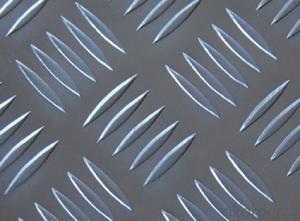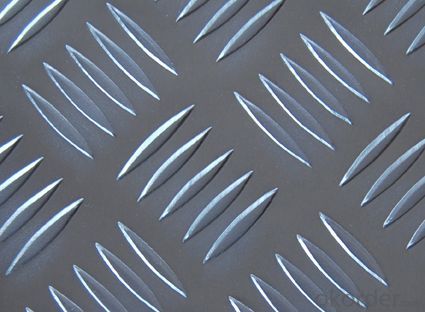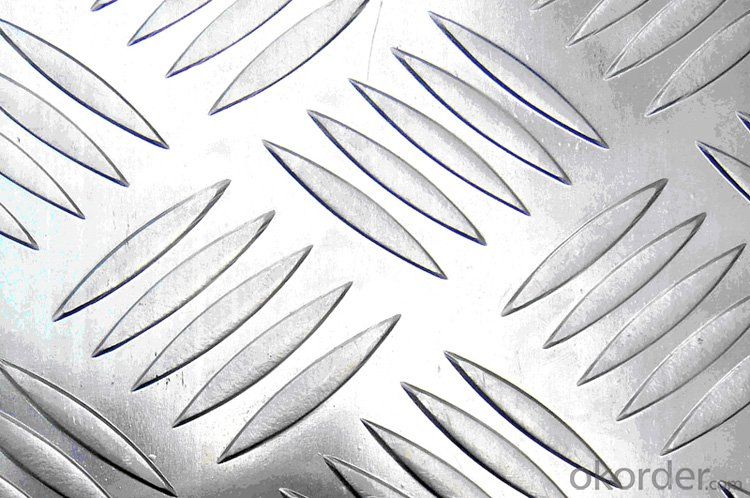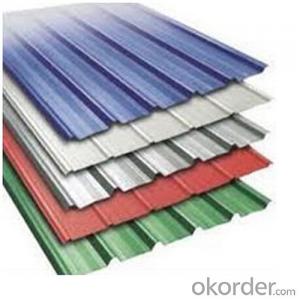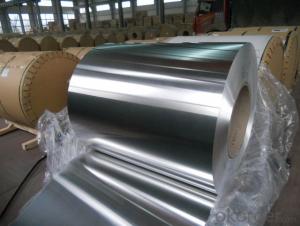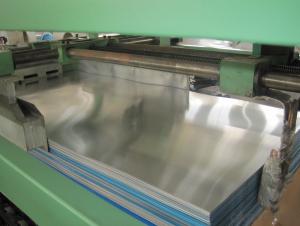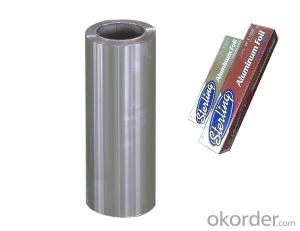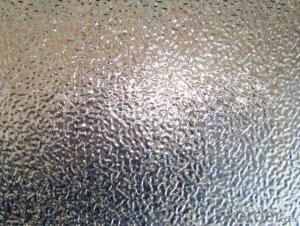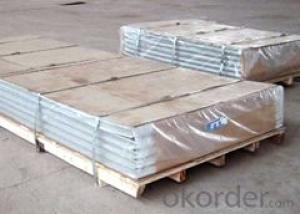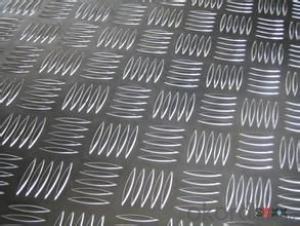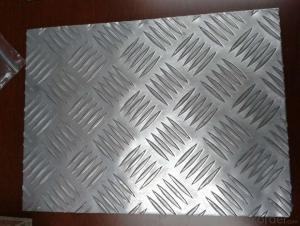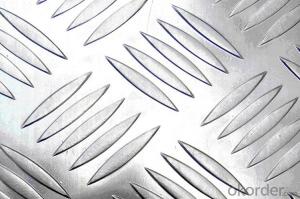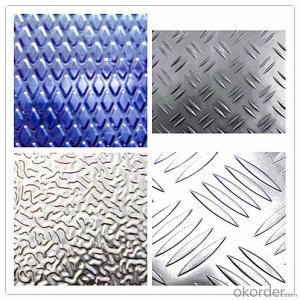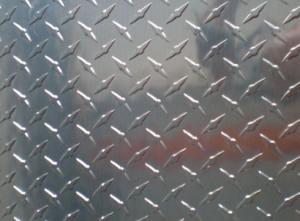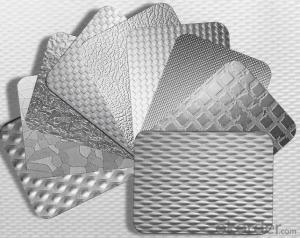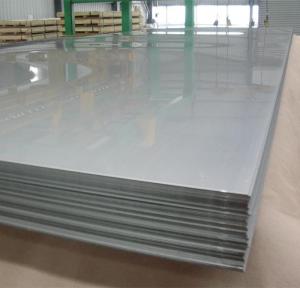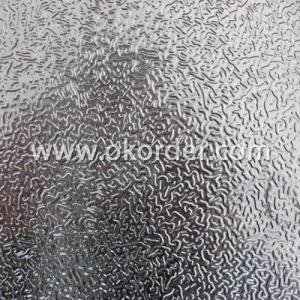Aluminum Sheets for Walls - Alu Plate with 5 Bars Pattern
- Loading Port:
- China Main Port
- Payment Terms:
- TT OR LC
- Min Order Qty:
- -
- Supply Capability:
- -
OKorder Service Pledge
OKorder Financial Service
You Might Also Like
Aluminium is a relatively soft,durable, lightweight, ductile and malleablemetal with appearance ranging from silvery to dull gray,depending on the surface roughness. It is nonmagnetic and does not easilyignite. A fresh film of aluminium serves as a good reflector (approximately92%) of visible light and an excellent reflector (as much as98%) of medium and far infrared radiation. The yield strength of pure aluminium is 7–11 MPa,while aluminium alloys have yield strengths ranging from200 MPa to 600 MPa. Aluminium has about one-third the density and stiffnessof steel. It iseasily machined,cast, drawn and extruded.
Alu Plate
Aluminum trade plate have great suctility,heat conductivity, anti-corrosion and moisture resistance properties.
Alloy: AA1050,1060, 1100, AA3003, 3005, 3015, 5052, 5754, 5083,8011, etc
Temper: H14/16/18/22/24/32,HO etc.
Thickness:0.2mm—100mm
Width:100mm—2300mm (Can be slitted)
Application:
Anti-sliperypurpose in vehicles, packing and appliance, decorative purpose
Features:
1. Excellent quality of products
2. Quick delivery
3. Best service to clients
4. BV,SGS avalible
5. No buckle o waveness
6. Tension leveling
7. Certificate of Origin
8. Form A,E
Packaging Detail: Carton ,Wooden pallet with plastic protection packing,standard seaworthy packing or as your request.
ProductionCapacity:
AnnualProduction capacity of 600,000 tons.
Products areexported to United States, Canada, U.A.E, Brazil, Mexico,Thailand, Vietnam,Nigeria etc, over 100 countries andregions all over the world.
Coveredfactories with full production line
CNBM aluminumproduction base is comprised of 18 aluminumannealers, 10 coil and foilmills, 4 continuous production lines, 2hot rolling production line and 3prepainted lines.
FAQ:
1. What is the form of payment?
Normally 30% TT, L/C
2. Type of quotation?
FOB, CFR, CIF
3. Port of loading?
Shanghai port
4. Delivery time?
30 day after client’s deposit
- Q: What are the different types of edges available for aluminum sheets?
- Some of the different types of edges available for aluminum sheets include straight edges, beveled edges, hemmed edges, and rounded edges.
- Q: What are the different methods of surface treatment for aluminum sheets?
- There are several methods of surface treatment for aluminum sheets, each serving different purposes and achieving specific results. Some common methods include anodizing, chromate conversion coating, painting, and powder coating. Anodizing is a popular method used to enhance the corrosion resistance and durability of aluminum sheets. It involves immersing the sheets in an electrolytic bath and applying an electric current to create a controlled oxide layer on the surface. This process results in a protective and decorative coating that can be further colored or sealed. Chromate conversion coating, also known as chemical conversion coating or chromating, involves coating the aluminum sheets with a thin layer of chromate. This method provides excellent corrosion resistance and improves paint adhesion. Chromate conversion coatings can be clear or have a yellowish or iridescent appearance. Painting is another method widely used to protect aluminum sheets and enhance their aesthetic appeal. The sheets are typically pre-treated with a primer to improve adhesion, and then a topcoat is applied for protection and color. Painted aluminum sheets come in a vast range of colors and finishes, making them suitable for various applications. Powder coating is a durable and environmentally friendly method of surface treatment for aluminum sheets. It involves electrostatically applying a dry powder onto the sheets and then curing them in an oven. The powder melts and fuses to form a tough and attractive coating. Powder coating offers excellent resistance to corrosion, chemicals, and UV radiation. In addition to these methods, there are other surface treatment techniques such as polishing, buffing, and mechanical finishes that can be employed to achieve specific desired appearances or surface qualities. Overall, the choice of surface treatment method for aluminum sheets depends on factors such as the desired level of corrosion resistance, aesthetic requirements, environmental considerations, and the intended application of the sheets.
- Q: What are the different alloy compositions available for aluminum sheets?
- There are various alloy compositions available for aluminum sheets, including 1xxx, 3xxx, 5xxx, and 6xxx series. Each series has unique properties and characteristics, making them suitable for different applications.
- Q: Are aluminum sheets suitable for food packaging?
- Aluminum sheets prove to be a suitable option for food packaging. The food industry widely embraces aluminum due to its unique attributes. Its lightweight nature, flexibility, and exceptional barrier properties shield the contents from external factors like moisture, light, and oxygen. Consequently, these properties help maintain the freshness and quality of the food products. In addition, aluminum resists corrosion and does not interact with acidic or alkaline substances, guaranteeing the preservation of taste and quality. Moreover, aluminum sheets can be effortlessly molded into diverse shapes, making them perfect for various forms of food packaging such as trays, containers, and foil wraps. All in all, aluminum sheets offer a safe and efficient choice for food packaging, ensuring durability, protection, and convenience.
- Q: Can aluminum sheets be used for reflective insulation?
- Yes, aluminum sheets can be used for reflective insulation. Aluminum is highly reflective and has good thermal conductivity, making it an excellent choice for reflecting heat and reducing heat transfer. When used as insulation, aluminum sheets can reflect heat away from the surface, preventing it from entering or escaping the desired area. This can help in maintaining a comfortable temperature inside a building or protecting sensitive equipment from extreme heat or cold. Additionally, aluminum sheets are lightweight and easy to install, making them a popular choice for reflective insulation applications.
- Q: Are aluminum sheets suitable for electrical applications?
- Yes, aluminum sheets are suitable for electrical applications. Aluminum is a highly conductive metal, and its use in electrical applications has become increasingly popular due to its numerous advantages. Firstly, aluminum is lightweight and offers excellent heat dissipation properties, making it an ideal choice for applications that require efficient thermal management. This is particularly important in electrical systems where heat can be generated, such as power transmission lines, electrical panels, and heat sinks. Secondly, aluminum sheets are highly corrosion-resistant. Unlike some other metals, aluminum forms a protective oxide layer on its surface, preventing further oxidation and corrosion. This makes it a reliable choice for electrical applications that are exposed to harsh environments or moisture. Additionally, aluminum is a cost-effective option compared to other metals commonly used in electrical applications, such as copper. It is readily available and has a lower price point, making it an attractive choice for manufacturers and consumers alike. However, it is important to note that aluminum has a lower electrical conductivity compared to copper. This means that for certain applications where high conductivity is crucial, such as in power transmission lines, copper may still be preferred. Nevertheless, advancements in technology and design have allowed aluminum to be used effectively in a wide range of electrical applications, from wiring and connectors to bus bars and transformers. In conclusion, aluminum sheets are indeed suitable for electrical applications, offering benefits such as lightweight construction, excellent thermal management, corrosion resistance, and cost-effectiveness. The final decision on whether to use aluminum or another material ultimately depends on the specific requirements and constraints of the electrical application in question.
- Q: Are aluminum sheets resistant to abrasion?
- Yes, aluminum sheets are generally resistant to abrasion. Aluminum is known for its durability and strength, making it resistant to scratches or damage caused by abrasion. However, the level of resistance may vary depending on the specific alloy and thickness of the aluminum sheet. Thicker sheets with higher alloy content tend to provide better resistance against abrasion. Additionally, the surface finish of the aluminum sheet can also play a role in its resistance to abrasion. Overall, aluminum sheets are a reliable choice when it comes to withstanding abrasion in various applications.
- Q: Status of aluminum sheet F
- The condition code only indicates that the product is in the natural aging stageT heat treatment status (different from F, O, H state) applicable to heat treatment, after (or without) hardening work to achieve stable products,.T code must be followed by one or more Arabia digital
- Q: What's the difference between laser cutting aluminum plate and stainless steel plate?
- Aluminum plate reflectivity high, viscous strong, general 3mm above will hang slag, but very easy to peel off, stainless steel cutting ability and thickness and equipment power relationship more.
- Q: It seemed in my experiment that aluminum wasn't reactive at all in the displacement reactions, except with copper sulfate. Is there a reason? or did I make a mistake? aluminum is more reactive than e.g silver nitrate, why didn't it react with it?
- Aluminium has a protective coating of Aluminium Oxide, this prevents many chemicals reaching the surface. This is because aluminium has a very strong affinity for oxygen and bonds to it with extremely strong bonds. It can be removed by dipping it carefully into a solution of Mercury (II) Chloride.
Send your message to us
Aluminum Sheets for Walls - Alu Plate with 5 Bars Pattern
- Loading Port:
- China Main Port
- Payment Terms:
- TT OR LC
- Min Order Qty:
- -
- Supply Capability:
- -
OKorder Service Pledge
OKorder Financial Service
Similar products
Hot products
Hot Searches
Related keywords
